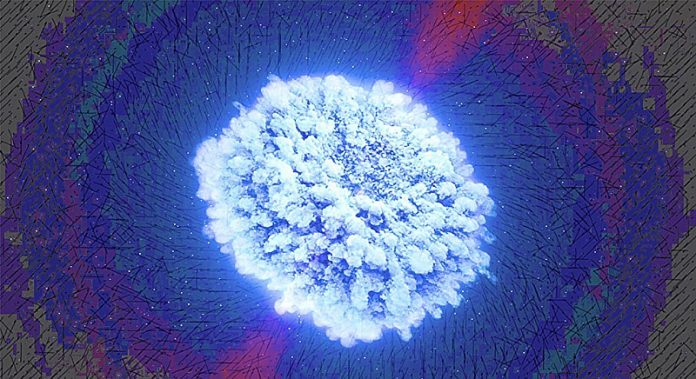
Astrophysicists have observed an extraordinary event following the collision of two neutron stars—the explosive birth of a black hole and the intense “dance” of electrons in the glowing aftermath.
This discovery, led by researchers from the Niels Bohr Institute, is published in Astronomy & Astrophysics and offers new insights into the extreme conditions of these cosmic events.
When two neutron stars collide, they produce an immense explosion called a kilonova, a fireball that shines as brightly as hundreds of millions of suns.
The explosion also results in the creation of heavy elements through the radioactive decay of matter ejected from the stars, which releases large amounts of energy.
By examining light from the kilonova, scientists were able to measure the temperatures and behaviors of particles, marking the first time microscopic properties have been observed in a neutron star collision.
To capture the full picture of the kilonova, telescopes from around the world, including those in Australia, South Africa, and the Hubble Space Telescope, were used to observe the event.
Each telescope could only catch a short part of the explosion due to Earth’s rotation, but by combining all the data, the researchers could piece together the event in detail.
“The combined data tells us more than any single observation could,” explains Albert Sneppen, a Ph.D. student at the Niels Bohr Institute and the lead researcher.
The temperatures after the collision were astonishingly high—about a thousand times hotter than the sun’s core, similar to the temperature of the universe just seconds after the Big Bang.
At these temperatures, electrons are not bound to atoms but instead move freely in a hot, ionized plasma, creating what scientists call the “dance” of electrons.
As the explosion cools over minutes, hours, and days, the electrons gradually attach to atomic nuclei to form atoms, much like the early universe cooled and allowed the formation of the first atoms.
The researchers found a “fingerprint” of the heavy elements strontium and yttrium in the explosion, showing that such collisions are indeed sources of these heavy elements.
This discovery could help explain the origin of many other elements heavier than iron, which scientists have long speculated come from such extreme cosmic events.
As the matter from the explosion expands rapidly, light takes hours to cross the massive fireball. By observing the light from different parts of the explosion, scientists can see stages of cooling and atomic formation in various areas of the kilonova. This unique view allows them to watch the formation of atoms from “before” to “after” as the explosion unfolds.
Rasmus Damgaard, a co-author and Ph.D. student at the Cosmic DAWN Center, compares it to observing the “cosmic background radiation” that gives us the earliest light from the universe. In this case, though, we are watching the process happen in real-time, from a distance.
These findings offer a rare glimpse into the creation of heavy elements and help answer long-standing questions about how elements in the universe came to be.



